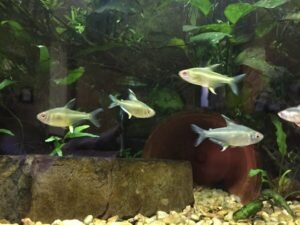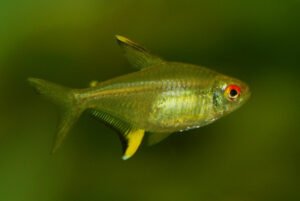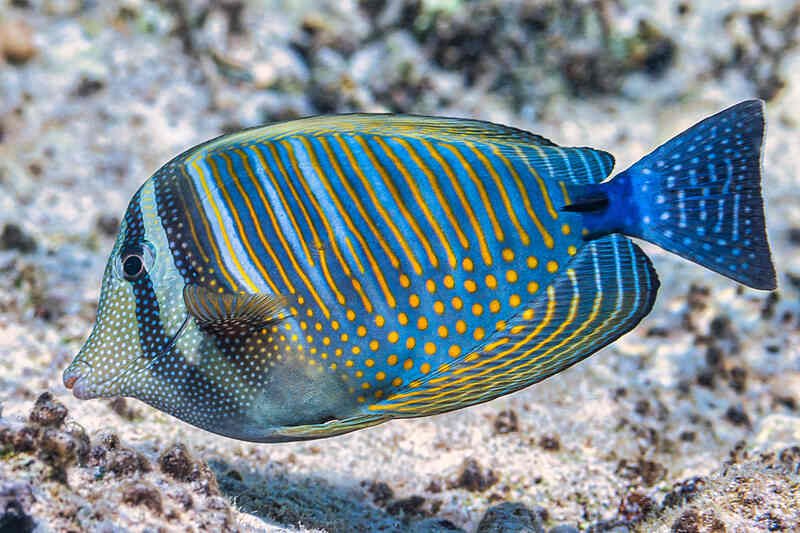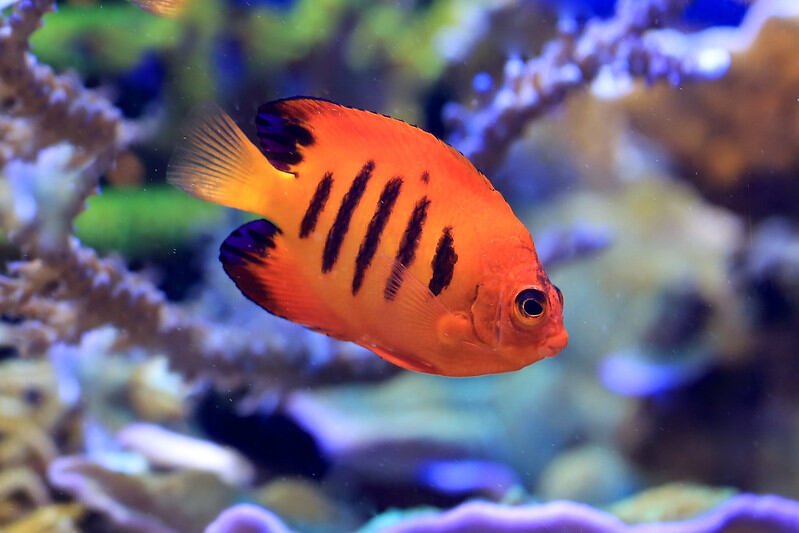Lemon Tetras, with their shimmering yellow hues and vibrant personalities, has become a favorite among aquarium enthusiasts, myself included. When I first decided to add Lemon Tetras to my tank, I was captivated by their lively nature and striking appearance. However, caring for these fish has been a learning journey filled with insights and rewarding experiences.
In this guide, I’ll share everything you need to know about keeping Tetras, from tank setup and water conditions to feeding and breeding. Let’s dive in!
Lemon Tetras care
The Lemon Tetra (Hyphessobrycon pulchripinnis) is a small freshwater fish native to the rivers of South America, particularly in the Amazon Basin. Known for their vivid yellow coloration and reflective silver bodies, these fish are perfect for community tanks. They typically grow to about 1.5 to 2 inches in length, making them a manageable size for both beginners and experienced aquarists.
I decided to introduce Tetras into my aquarium primarily for their peaceful temperament and vibrant look. Initially, I had only seen them in stores, but keeping them at home brought an entirely new appreciation for these little gems.
Setting Up the Ideal Tank
Creating a suitable environment for Tetras was one of the first things I focused on. Here are the key aspects to consider when setting up their tank:
Tank Size
While Tetras are small, they are also active swimmers who appreciate ample space. I found that a 20-gallon tank was a great starting point for a school of 6 to 8 Tetras. This size allows them to swim freely while providing enough room for decorations and plants.
Water Conditions
Maintaining stable water parameters is crucial for the health of Tetras. I aimed for the following conditions:
- Temperature: Between 72°F and 82°F. I set my aquarium heater to around 76°F, which seemed to be the sweet spot for keeping the fish active.
- pH Level: Neutral to slightly acidic (6.0–7.5). Regular water testing helped me keep the pH stable, avoiding sudden fluctuations.
- Water Hardness: Soft to moderately hard (3–15 dGH). I used a mix of tap and filtered water to maintain suitable hardness levels.
Water changes were done weekly, replacing about 20–30% of the tank water to keep the environment clean. I learned the hard way that skipping water changes can lead to stressed fish and health issues.
Filtration
I used a gentle filter that provided enough circulation without creating strong currents. Tetras prefer calmer waters, similar to their natural habitat. I chose a sponge filter, which works well by ensuring adequate filtration while not disturbing the fish too much.
Lighting
A moderate lighting setup is perfect for Tetras, as too much brightness can cause stress. I used an adjustable LED light with a timer to simulate a natural day-night cycle. This helped the fish maintain a routine, enhancing their coloration and behavior.
Aquascaping: Plants and Decorations
Lemon Tetras thrive in a well-planted tank, as it mimics their natural environment and provides plenty of hiding spots. I opted for live plants like Amazon Swords, Java Fern, and Anubias. These plants not only created a natural look but also helped maintain water quality by absorbing nitrates.
Adding some driftwood and smooth rocks gave the tank a more authentic appearance. I arranged the decorations in a way that allowed open swimming areas in the center while keeping the edges densely planted. This setup encouraged the Lemon Tetras to swim together in schools, making for a captivating display.
Feeding Lemon Tetras: A Balanced Diet
One of the joys of keeping Tetras is feeding them. They are not picky eaters, but providing a varied diet is essential for their health and color vibrancy. Here’s what worked best for me:
Staple Foods
- Flake Food: I fed high-quality tropical flake food as the staple diet. The flakes are small enough for Tetras to eat comfortably.
- Pellets: Occasionally, I offered micro pellets, which helped to vary their diet.
Protein-Rich Foods
- Frozen or Live Foods: Bloodworms, brine shrimp, and daphnia made excellent treats. I included these about twice a week, as they are rich in protein and enhance the fish’s color.
- Freeze-Dried Foods: When fresh or live food wasn’t available, I used freeze-dried alternatives like tubifex worms.
Vegetable-Based Foods
While Tetras are omnivores, they enjoy plant matter as well. I supplemented their diet with spirulina flakes and blanched vegetables like spinach or zucchini. This addition provided essential nutrients and kept their digestive systems in good shape.
Feeding them small amounts two to three times daily prevented overfeeding. I observed that they were more active and showcased brighter colors when I kept feeding times consistent.
Tank Mates: Who Gets Along with Lemon Tetras?
Lemon Tetras are peaceful, making them suitable for community aquariums. When choosing tank mates, I considered fish with similar temperaments and water requirements. Some compatible species that I’ve had success with include:
- Other Tetras: I added Neon and Ember Tetras, which coexisted without issues.
- Corydoras Catfish: These bottom-dwellers made great companions and helped keep the substrate clean.
- Dwarf Gouramis: Though larger, they did not pose a threat to the Tetras.
- Small Rasboras and Guppies: Both worked well as tank mates, sharing similar space without conflicts.
I avoided large or aggressive fish like Cichlids, which could intimidate or harm the Tetras. Keeping them in a peaceful environment allowed them to display natural schooling behavior and reduced stress.
Health and Common Issues
Like all fish, Tetras are prone to certain health problems. Regular observation helped me detect issues early, and here’s how I handled some of the common problems:
Ich (White Spot Disease)
The parasite condition known as ich causes white spots on the fish’s body. When I noticed it in my tank, I promptly raised the water temperature to 82°F and added aquarium salt to help combat the parasites. Medication specifically for Ich also helped clear up the infection within a week.
Fin Rot
Occasionally, I observed torn fins, which turned out to be fin rot caused by poor water quality. Performing more frequent water changes and using medication for fin rot helped resolve this issue. Indian almond leaves also contribute to a healthier environment by releasing natural tannins into the water.
Stress
Stress in Tetras often showed up as faded colors or erratic swimming. This usually happens when there are sudden changes in water parameters or a lack of hiding places. To minimize stress, I made sure to acclimate new fish slowly and maintained a stable tank environment.
Breeding Lemon Tetras: My Experience
Breeding Tetras was a challenging but rewarding experience. Here’s how I managed to encourage spawning:
Setting Up the Breeding Tank
I prepared a separate 10-gallon breeding tank with soft, acidic water (pH around 6.5) and a slightly higher temperature of 78°F. I used a sponge filter to avoid harming the fry and added fine-leaved plants like Java Moss for the eggs to adhere to.
Conditioning the Fish
Before attempting to breed, I conditioned the fish with a diet rich in live and frozen foods for about two weeks. The females became noticeably rounder, indicating they were carrying eggs.
Spawning Process
Once the male started displaying courtship behavior, I introduced the pair into the breeding tank. Spawning usually occurred early in the morning, and the eggs would scatter among the plants. I promptly removed the adults afterward to prevent them from eating the eggs.
Raising the Fry
The eggs hatched within 48 hours, and I fed the fry infusoria or commercially available liquid fry food initially. As they grew, I transitioned to baby brine shrimp. Keeping the breeding tank clean was crucial, as the fry was particularly sensitive to water conditions.
Tips for Keeping Lemon Tetras Happy
Reflecting on my experience, here are some tips for maintaining a thriving Lemon Tetra tank:
- Keep Them in Schools: Tetras feel more secure and display better colors when kept in groups of at least six.
- Maintain Consistent Water Conditions: Regular water testing and maintenance are key to preventing stress and disease.
- Feed a Varied Diet: A balanced mix of flake, live, and vegetable-based foods keeps the fish healthy and vibrant.
- Provide Plenty of Hiding Spots: Dense plants and decorations help mimic their natural habitat and reduce stress.
- Use a Gentle Filter: Avoid strong currents, as these fish prefer calmer waters.
A Freshwater Aquarium Story
Lemon Tetras have always been one of my favorite freshwater aquarium fish. Their vibrant yellow hues and lively behavior add a splash of color to any tank, making them a popular choice among aquarists. Over the years, I’ve come to appreciate their unique qualities and learned quite a bit about caring for them, from setting up the right environment to ensuring they stay healthy. Here’s my story of keeping Tetras and the valuable lessons I’ve gathered along the way.
Discovering Lemon Tetras
My journey with Tetras began when I was searching for a colorful and peaceful species to add to my community tank. The local aquarium store had a school of them swimming in perfect harmony, their bodies glistening with a lemon-yellow color that was simply mesmerizing. I was instantly drawn to their appearance and curious about their behavior, so I decided to add a small school of six Lemon Tetras to my 30-gallon freshwater tank.
The Challenges of Acclimation
Despite the efforts I put into creating a suitable habitat, the first few days were a bit challenging. Tetras are sensitive to changes in water parameters, and it took some time for them to acclimate to their new home. I noticed that they were slightly stressed, swimming near the bottom and displaying subdued colors. To help them settle in, I made sure the water conditions were optimal, keeping the temperature at around 75-82°F and maintaining a pH of 6.5-7.5.
I also performed small water changes every other day to keep the tank clean and reduce any potential toxins. Slowly but surely, the Tetras began to explore their surroundings, and their bright yellow coloration returned, signaling that they were finally adapting to the environment.
Feeding Habits and Preferences
One of the most enjoyable aspects of keeping Tetras is observing their feeding habits. They are not picky eaters, but I found that they thrive on a varied diet. I started by feeding them high-quality flake food specifically formulated for tropical fish, which provided them with the necessary nutrients. To add diversity, I occasionally offered them frozen or live foods such as brine shrimp and daphnia. These treats not only boosted their color but also kept them active and engaged.
I noticed that the Tetras preferred eating in the middle and upper sections of the tank, where they would eagerly swim to catch food. However, feeding too much at once would lead to uneaten food sinking to the bottom, which could affect the water quality. So, I made it a habit to feed them small amounts twice a day, ensuring that everything was consumed within a few minutes.
Social Behavior and Schooling
Lemon Tetras are schooling fish, and I quickly realized how important it was for them to be kept in groups. Initially, I had six, but over time, I decided to increase the group size to ten. This change made a noticeable difference in their behavior. When kept in a larger school, the Tetras were more confident, and active, and displayed more vibrant colors. They would swim together in a coordinated manner, often darting around the tank in synchronized movements, which was fascinating to watch.
I also learned that Tetras can sometimes exhibit territorial behavior, particularly when they are in smaller groups or feel stressed. However, as long as they were in a group of at least six, their interactions remained friendly and harmonious. Keeping a larger school not only enhanced the visual appeal of the aquarium but also contributed to the overall well-being of the fish.
Tankmates and Compatibility
One of the reasons I chose Tetras was their peaceful nature, which makes them suitable for community tanks. I kept them alongside other small, non-aggressive species such as Corydoras catfish, Otocinclus, and Cherry Shrimp. These tankmates coexisted peacefully with the Tetras, and there were no issues with aggression or competition for food. The diverse range of species added more dynamic behavior to the tank, creating a vibrant underwater ecosystem.
I did avoid adding larger or more aggressive fish, like Cichlids, as they could potentially stress or even prey on the Tetras. Maintaining a harmonious community required careful selection of compatible species, which ultimately contributed to the thriving aquarium environment.
Overcoming Common Health Issues
Throughout my experience, there were a few health challenges with the Tetras, mostly related to water quality. Like many freshwater fish and saltwater fish, they are susceptible to fin rot and Ich if the tank conditions aren’t ideal. I made it a priority to regularly test the water parameters and perform routine water changes to keep the nitrate and ammonia levels low. On one occasion, when I noticed a few Tetras developing white spots indicative of Ich, I promptly treated the tank with a fish-safe medication and increased the water temperature slightly to speed up the recovery process. Fortunately, the issue was resolved quickly, and there were no lasting effects.
Breeding Observations
While I didn’t initially set out to breed Tetras, I did observe some signs of mating behavior, especially during the warmer months when the water temperature was slightly higher. The males became more colorful, and the Tetras would chase each other around the plants. Although I never separated the breeding pair or made any special preparations for spawning, the occasional presence of small fry in the tank was a delightful surprise. However, the fry was often eaten by other tankmates, as I wasn’t specifically aiming for breeding success.
Reflections on Keeping Lemon Tetras
Looking back, keeping Tetras has been a rewarding experience. Their bright colors, active schooling behavior, and peaceful nature make them an excellent choice for both novice and experienced aquarists. Over time, I’ve learned that maintaining a stable and clean environment is key to their health and happiness and that they thrive best in a well-planted tank with plenty of companions.
For anyone considering adding Tetras to their aquarium, I would highly recommend doing so. Their presence brings life and energy to any freshwater setup, and their relatively low maintenance makes them suitable for aquarists at any level. Keeping these little yellow gems has not only enhanced my appreciation for fishkeeping but also deepened my understanding of aquatic life.
Final Thoughts
Caring for Tetras has been an incredibly rewarding journey, filled with moments of learning and joy. Their beautiful colors, peaceful nature, and fascinating behaviors make them a fantastic addition to any community aquarium. By understanding their needs and providing the right environment, you can enjoy the charm of these captivating fish in your tank.





